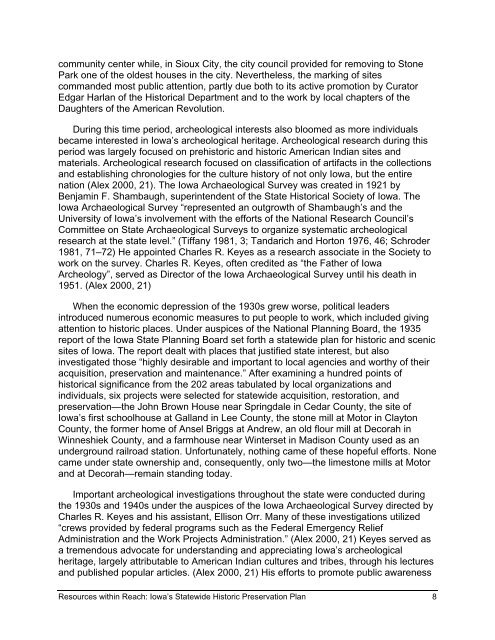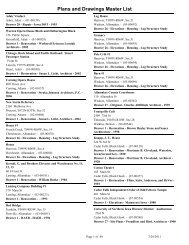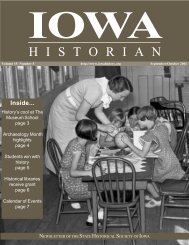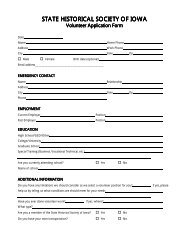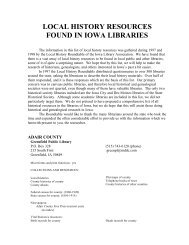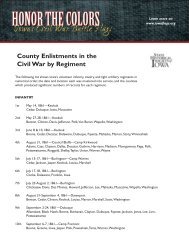community center while, in Sioux City, the city council provided for removing to StonePark one <strong>of</strong> the oldest houses in the city. Nevertheless, the marking <strong>of</strong> sitescommanded most public attention, partly due both to its active promotion by CuratorEdgar Harlan <strong>of</strong> the <strong>Historical</strong> Department and to the work by local chapters <strong>of</strong> theDaughters <strong>of</strong> the American Revolution.During this time period, archeological interests also bloomed as more individualsbecame interested in <strong>Iowa</strong>’s archeological heritage. Archeological research during thisperiod was largely focused on prehistoric and historic American Indian sites andmaterials. Archeological research focused on classification <strong>of</strong> artifacts in the collectionsand establishing chronologies for the culture history <strong>of</strong> not only <strong>Iowa</strong>, but the entirenation (Alex 2000, 21). The <strong>Iowa</strong> Archaeological Survey was created in 1921 byBenjamin F. Shambaugh, superintendent <strong>of</strong> the <strong>State</strong> <strong>Historical</strong> <strong>Society</strong> <strong>of</strong> <strong>Iowa</strong>. The<strong>Iowa</strong> Archaeological Survey “represented an outgrowth <strong>of</strong> Shambaugh’s and theUniversity <strong>of</strong> <strong>Iowa</strong>’s involvement with the efforts <strong>of</strong> the National Research Council’sCommittee on <strong>State</strong> Archaeological Surveys to organize systematic archeologicalresearch at the state level.” (Tiffany 1981, 3; Tandarich and Horton 1976, 46; Schroder1981, 71–72) He appointed Charles R. Keyes as a research associate in the <strong>Society</strong> towork on the survey. Charles R. Keyes, <strong>of</strong>ten credited as “the Father <strong>of</strong> <strong>Iowa</strong>Archeology”, served as Director <strong>of</strong> the <strong>Iowa</strong> Archaeological Survey until his death in1951. (Alex 2000, 21)When the economic depression <strong>of</strong> the 1930s grew worse, political leadersintroduced numerous economic measures to put people to work, which included givingattention to historic places. Under auspices <strong>of</strong> the National Planning Board, the 1935report <strong>of</strong> the <strong>Iowa</strong> <strong>State</strong> Planning Board set forth a statewide plan for historic and scenicsites <strong>of</strong> <strong>Iowa</strong>. The report dealt with places that justified state interest, but alsoinvestigated those “highly desirable and important to local agencies and worthy <strong>of</strong> theiracquisition, preservation and maintenance.” After examining a hundred points <strong>of</strong>historical significance from the 202 areas tabulated by local organizations andindividuals, six projects were selected for statewide acquisition, restoration, andpreservation—the John Brown House near Springdale in Cedar County, the site <strong>of</strong><strong>Iowa</strong>’s first schoolhouse at Galland in Lee County, the stone mill at Motor in ClaytonCounty, the former home <strong>of</strong> Ansel Briggs at Andrew, an old flour mill at Decorah inWinneshiek County, and a farmhouse near Winterset in Madison County used as anunderground railroad station. Unfortunately, nothing came <strong>of</strong> these hopeful efforts. Nonecame under state ownership and, consequently, only two—the limestone mills at Motorand at Decorah—remain standing today.Important archeological investigations throughout the state were conducted duringthe 1930s and 1940s under the auspices <strong>of</strong> the <strong>Iowa</strong> Archaeological Survey directed byCharles R. Keyes and his assistant, Ellison Orr. Many <strong>of</strong> these investigations utilized“crews provided by federal programs such as the Federal Emergency ReliefAdministration and the Work Projects Administration.” (Alex 2000, 21) Keyes served asa tremendous advocate for understanding and appreciating <strong>Iowa</strong>’s archeologicalheritage, largely attributable to American Indian cultures and tribes, through his lecturesand published popular articles. (Alex 2000, 21) His efforts to promote public awareness<strong>Resources</strong> <strong>within</strong> <strong>Reach</strong>: <strong>Iowa</strong>’s <strong>State</strong>wide Historic Preservation Plan 8
<strong>of</strong> archeological resources and <strong>Iowa</strong>’s archeological heritage during the 1930s and1940s served as the impetus for the creation <strong>of</strong> the <strong>Iowa</strong> Archeological <strong>Society</strong> in 1951.Keyes efforts also led eventually to the acquisition <strong>of</strong> public funds for archeologicalresearch and the creation <strong>of</strong> a <strong>State</strong> Archaeologist position and Office in 1955. (Alex2000, 21) Keyes, Orr, and some <strong>of</strong> the founding trustees <strong>of</strong> the <strong>Iowa</strong> Archeological<strong>Society</strong> played significant roles in the eventual establishment <strong>of</strong> Effigy Mounds NationalMonument in northeastern <strong>Iowa</strong> in 1949, which was originally proposed by Keyes andOrr as Mississippi Valley National Park. (Tandarich and Horton 1976, 46)In order to revive waning public appreciation for historic sites in the decade afterWorld War II, three individuals took steps in 1956 to form what would become The <strong>Iowa</strong><strong>Society</strong> for the Preservation <strong>of</strong> Historic Landmarks—George Mills <strong>of</strong> the Des MoinesRegister and Tribune, Leonard Wolf with the Department <strong>of</strong> Architecture andArchitectural Engineering at <strong>Iowa</strong> <strong>State</strong> College, and William Wagner, an architect fromDallas Center. Through the <strong>Society</strong>’s efforts, members set a steady gaze on what washappening to historic places and made numerous visits to the sites, which showed thatothers across the state were concerned about the fate <strong>of</strong> <strong>Iowa</strong>’s historic places. Theirwork continued through the next four decades and formed a worthy transition to themovement that rose after passage <strong>of</strong> the National Historic Preservation Act <strong>of</strong> 1966.Beginning in 1971, a number <strong>of</strong> American Indians raised issues with the Governor <strong>of</strong><strong>Iowa</strong>, <strong>State</strong> Legislators, and the <strong>State</strong> Archaeologist regarding the differential treatment<strong>of</strong> American Indian human remains and burials in <strong>Iowa</strong>. An incident on an <strong>Iowa</strong>Department <strong>of</strong> Transportation project in 1971 incensed the American Indian community.One individual in particular, Maria Pearson (a Yankton Sioux tribal member), began along journey <strong>of</strong> advocacy for equal treatment and protection <strong>of</strong> American Indian humanremains and burials. Pearson’s efforts, along with several other individuals includingDonald Wanatee, Sr. (a Meskwaki tribal member), eventually led to the creation <strong>of</strong> astate burial law enacted in 1976. This state statute prohibited unauthorized excavation<strong>of</strong> ancient human remains, defined under the law as human remains 150 years <strong>of</strong> ageor older. The <strong>State</strong> Archaeologist was assigned the responsibility to investigate,interpret, and preserve ancient burial grounds, and when necessary, to recover andreinter ancient human skeletal remains under the state statute. An American IndianAdvisory Committee (now Council) to the Office <strong>of</strong> the <strong>State</strong> Archaeologist was formedin the 1970s to provide advice and technical assistance to the <strong>State</strong> Archaeologist inadministering and implementing the state burial law. The early collaborative efforts indeveloping educational materials, programs, and management and preservation optionsfor human remains and burial sites included additional partners such as the <strong>State</strong><strong>Historical</strong> <strong>Society</strong> <strong>of</strong> <strong>Iowa</strong> and the <strong>State</strong> Historic Preservation Office. Thesecollaborative efforts continue today.The enactment <strong>of</strong> the state burial law spurred discussions between the pr<strong>of</strong>essionalarcheological community and American Indian community regarding the treatment <strong>of</strong>human remains and burials, sacred sites, and the interpretation <strong>of</strong> the archeologicalrecord relating to the American Indians. These continue to be topics <strong>of</strong> discussion both<strong>within</strong> the state and at the national level. The American Indian Advisory Council workedclosely with <strong>State</strong> Archaeologists Duane Anderson (1975 – 1986), William Green (1988<strong>Resources</strong> <strong>within</strong> <strong>Reach</strong>: <strong>Iowa</strong>’s <strong>State</strong>wide Historic Preservation Plan 9
- Page 1 and 2: Resources within ReachIowa’s Stat
- Page 3 and 4: THE PLANNING PROCESSLet us begin by
- Page 5 and 6: Out of the 2001 cultural caucus sta
- Page 7 and 8: • Develop comprehensive and excit
- Page 9: the commission will become a more a
- Page 14 and 15: concentrations of bungalow houses.
- Page 16 and 17: The second state grant incentive, a
- Page 18 and 19: PRESERVATION PARTNERSInterested in
- Page 20 and 21: Iowa Barn Foundation. Founded in 19
- Page 22 and 23: appreciation for historic propertie
- Page 24 and 25: AMERICAN INDIAN TRIBESThere is curr
- Page 26 and 27: settlements. Many of Iowa’s curre
- Page 28 and 29: onslaught of Euroamerican speculato
- Page 30 and 31: 1988—Appendix A, no. 2). It addre
- Page 32 and 33: (13CK405), Allen Fan Site (13HA382)
- Page 34 and 35: vessels. Based on archeological, et
- Page 36 and 37: Historical archeological investigat
- Page 38 and 39: ecame both catalyst and arbiter of
- Page 40 and 41: In Iowa the best known route to tra
- Page 42 and 43: element from Ireland. Over the next
- Page 44 and 45: flood events that occurred in Iowa
- Page 46 and 47: National Register of Historic Place
- Page 48 and 49: Four archeological sites and two ar
- Page 51 and 52: ased on available funding and confl
- Page 53 and 54: Understandably then, community advo
- Page 55 and 56: Objective 1-CExpand public apprecia
- Page 57 and 58: Objective 2-HPursue adoption of an
- Page 59 and 60: Objective 4-JDevelop communication
- Page 61 and 62:
BIBLIOGRAPHYGeneral WorksAlex, Lynn
- Page 63 and 64:
Gilder, Robert F. “Prehistoric Vi
- Page 65 and 66:
Sissel, Dewey Kent. “The Octagon
- Page 67 and 68:
17. Parrott, Charles. “An Archite
- Page 69 and 70:
47. Naumann, Molly Myers. “Archit
- Page 71 and 72:
77. Jacobsen, James E. “Capitol E
- Page 73 and 74:
• Indian Contact, Conflict, and D
- Page 75 and 76:
• Labor Movements and Organizatio
- Page 77 and 78:
APPENDIX C: IOWA CITIES AND COUNTIE
- Page 79 and 80:
APPENDIX E: SIGNIFICANT HISTORICPRE
- Page 81:
2005A promotional program for Iowa


